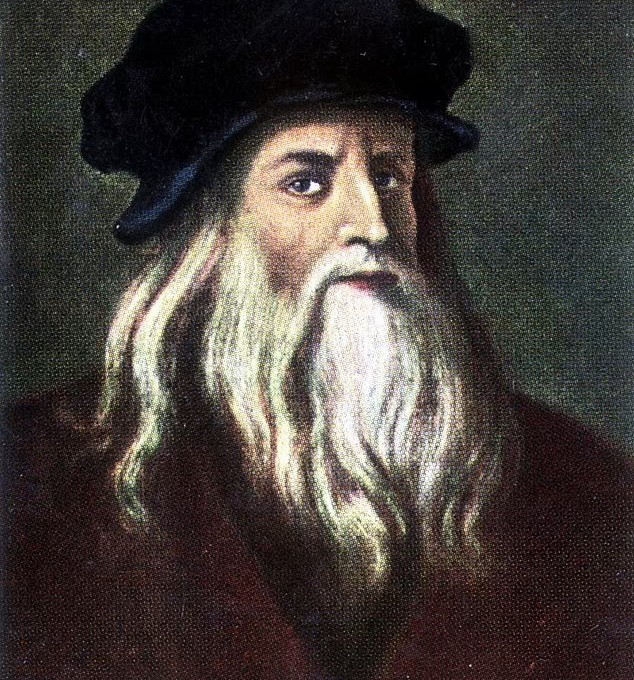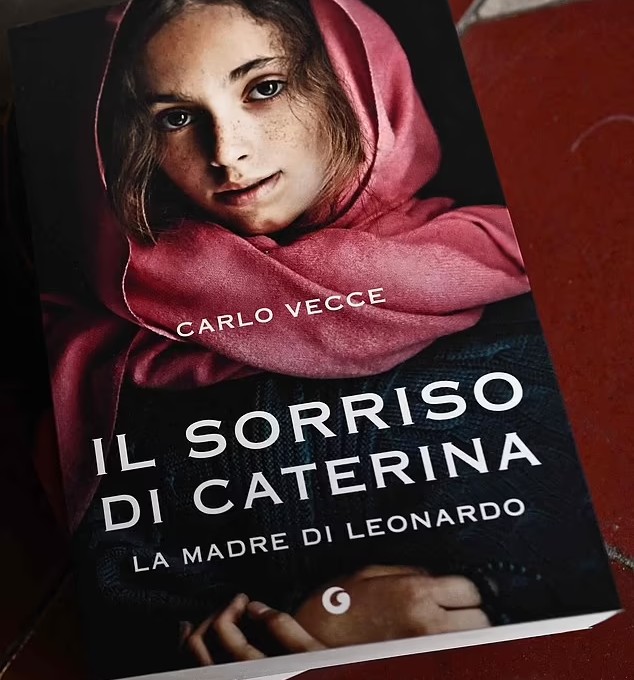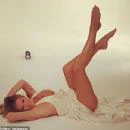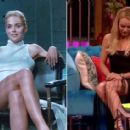Fabulous
Leonardo da Vinci's mother was a white SLAVE who was trafficked from the Caucasus mountains and sold many times before meeting his Italian notary father, new research reveals
- The Renaissance master was only half-Italian, a professor has claimed
- But any da Vinci discovery is hotly contested by the experts who study him
Leonardo da Vinci was only half-Italian as his mother was a slave from the Caucasus, research has revealed.
It was previously believed that da Vinci's mother Caterina was a Tuscan peasant - but an expert on the Renaissance master believes the truth is more complicated.
Carlo Vecce, a professor at the University of Naples, told AFP at the launch of his new book on the subject: 'Leonardo's mother was a Circassian slave... taken from her home in the Caucasus Mountains, sold and resold several times in Constantinople, then Venice, before arriving in Florence.'
In the Italian city, she met a young notary, Piero da Vinci, 'and their son was called Leonardo'.
The findings of Professor Vecce - who has spent decades studying da Vinci, whose works include the Mona Lisa - are based on Florence city archives.

His work has formed the basis of his new novel - The Smile of Caterina, the Mother of Leonardo - while also shedding new light on the artist himself.
Any new discovery about da Vinci is hotly contested by the group of experts who study him, but Professor Vecce, who is recognised as a leading scholar in the field, insists the evidence is there.
Among the documents he found is one written by da Vinci's father himself, a legal certificate of emancipation for Caterina, 'to recover her freedom and recover her human dignity'.
This document is dated 1452 - the year of da Vinci's birth - and was presented at a press conference at the headquarters of publishing house Giunti in Florence on Tuesday.
It was written by 'the man who loved Caterina when she was still a slave, who gave her this child named Leonardo and (was) also the person who helped to free her', Professor Vecce said.
His findings offers a radical change of perspective on da Vinci, whose mother, Caterina di Meo Lippi, was believed to have been a young Tuscan peasant woman, rather than a slave.
Historians already knew that, because of the nature of his birth in a village outside Florence, da Vinci did not receive the formal education that would have made it easy for him to follow in his father's footsteps and take up a profession.

Instead, he began his career as an apprentice in the studio of Florentine painter Verrocchio.
By the age of 18 he had become a member of the prestigious painters' guild, dressed in rose-coloured tunics and boasted a long curling beard.
Professor Vecce believes that the difficult life of his 'migrant' mother had an impact on the work of her brilliant son.
'Caterina left Leonardo a great legacy, certainly, the spirit of freedom which inspires all of his intellectual scientific work,' he said.
'He doesn't let anything stop him.'
Some may consider the idea that this epitome of a 'Renaissance man' was the product of such a union too good to be true.
Latest News
- The Renaissance master was only half-Italian, a professor has claimed
- But any da Vinci discovery is hotly contested by the experts who study him
Leonardo da Vinci was only half-Italian as his mother was a slave from the Caucasus, research has revealed.
It was previously believed that da Vinci's mother Caterina was a Tuscan peasant - but an expert on the Renaissance master believes the truth is more complicated.
Carlo Vecce, a professor at the University of Naples, told AFP at the launch of his new book on the subject: 'Leonardo's mother was a Circassian slave... taken from her home in the Caucasus Mountains, sold and resold several times in Constantinople, then Venice, before arriving in Florence.'
In the Italian city, she met a young notary, Piero da Vinci, 'and their son was called Leonardo'.
The findings of Professor Vecce - who has spent decades studying da Vinci, whose works include the Mona Lisa - are based on Florence city archives.

His work has formed the basis of his new novel - The Smile of Caterina, the Mother of Leonardo - while also shedding new light on the artist himself.
Any new discovery about da Vinci is hotly contested by the group of experts who study him, but Professor Vecce, who is recognised as a leading scholar in the field, insists the evidence is there.
Among the documents he found is one written by da Vinci's father himself, a legal certificate of emancipation for Caterina, 'to recover her freedom and recover her human dignity'.
This document is dated 1452 - the year of da Vinci's birth - and was presented at a press conference at the headquarters of publishing house Giunti in Florence on Tuesday.
It was written by 'the man who loved Caterina when she was still a slave, who gave her this child named Leonardo and (was) also the person who helped to free her', Professor Vecce said.
His findings offers a radical change of perspective on da Vinci, whose mother, Caterina di Meo Lippi, was believed to have been a young Tuscan peasant woman, rather than a slave.
Historians already knew that, because of the nature of his birth in a village outside Florence, da Vinci did not receive the formal education that would have made it easy for him to follow in his father's footsteps and take up a profession.

Instead, he began his career as an apprentice in the studio of Florentine painter Verrocchio.
By the age of 18 he had become a member of the prestigious painters' guild, dressed in rose-coloured tunics and boasted a long curling beard.
Professor Vecce believes that the difficult life of his 'migrant' mother had an impact on the work of her brilliant son.
'Caterina left Leonardo a great legacy, certainly, the spirit of freedom which inspires all of his intellectual scientific work,' he said.
'He doesn't let anything stop him.'
Some may consider the idea that this epitome of a 'Renaissance man' was the product of such a union too good to be true.

Jennifer Lopez looks ageless in a towel in no-makeup video

Amanda Holden spanks her derriere and thanks Spanx

Amanda Holden shows off more than bargained as she dances around in her outfit of the day

Meet Harley Cameron, the stunning model who went from a BKFC ring girl to become a pro wrestler and found love

GreenGirlBella, Rocks Emirates Stadium in Painted Home Kit

Amanda Holden calls herself a 'good girl' in white dress with 'cheeky' split

Mum slammed by parents after flashing thong in school run outfit

Lottie Moss makes jaws dropp as she shows off her flawless body

Amanda Holden wears nothing beneath plunging white dress












Comments
Written news comments are in no way https://www.showbizglow.com it does not reflect the opinions and thoughts of. Comments are binding on the person who wrote them.